I’m Watching “Futari wa Pretty Cure”, Episode 1 (And Some Background Information)
You know, just as I was about to consider writing articles on Substack, it turns out we all found out that Substack’s owners don’t appear…
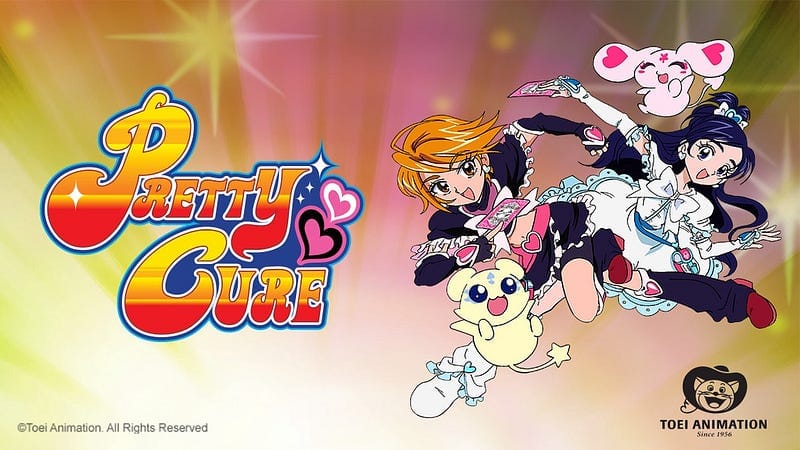
You know, just as I was about to consider writing articles on Substack, it turns out we all found out that Substack’s owners don’t appear to have a lot of problems with hate being platformed there. I don’t think Medium has a lot of eyes on it by comparison to some other outlets, but for the kind of writing I’m thinking of doing, I think Medium is just fine for now. Watch, though — I’m sure now that I’m trying to write here, someone’s going to reveal to me that there’s some horrible problem with Medium, too, that I wasn’t previously aware of.
Well, for now, this is fine. So, for today’s topic:
I’m really bad at blogging about things I’m watching, but I want to get into the habit of writing some more, so I’m starting with talking about the first episode of Futari wa Pretty Cure. So, why is this on my radar right now?
No real good reason, if I’m to be honest, other than I’ve had my eye on the franchise for a long time anyway. There’s going to be a lot of people a lot more knowledged about PreCure than I am. If I actually manage to keep up with blogging about this, there will be lots of people who are already far ahead of the game, and I won’t be saying anything new or creative, probably. But it’s such a long-running franchise, and so much of it has never been localized, that it’s just kind of been fascinating in a way. The PreCure franchise has been active for 20 years, and the modern images you see of it today with seemingly a bajillion young magical girls is now only barely recognizable to the originating series Futari wa Pretty Cure, which features only two lead magical girls.
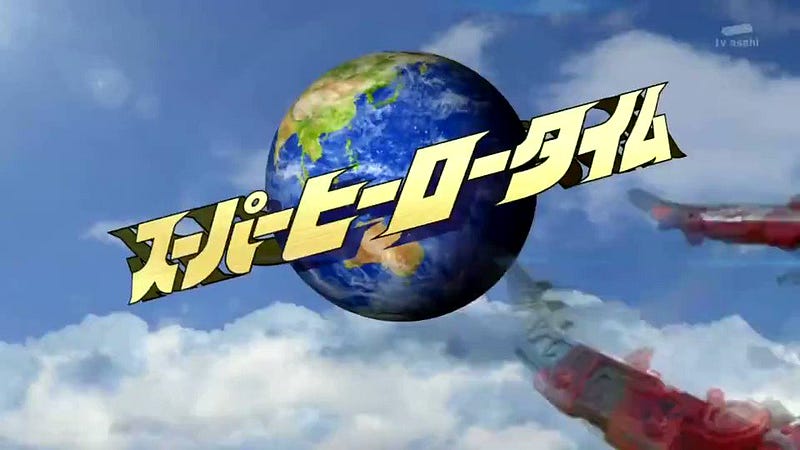
I’d previously tried a number of times to start watching this series (localized in many western regions including the US simply as Pretty Cure). Its presence is hard to avoid when you also watch Japanese live action tokusatsu (special effects) shows such as Kamen Rider and Super Sentai. These shows (both of which are produced by Toei’s live-action division and aimed at young boys) air on Sunday mornings in Japan on TV Asahi’s “Super Hero Time” childrens television block. But for years, the lead-in series to these shows on this station has been airings of the PreCure franchise, so lots of fans of these tokusatsu hero shows also strangely enough end up familiarizing themselves with this hero anime aimed at young girls. Some tokusatsu fans have even jokingly called PreCure a member of the “Super Hero Time” family, despite that not technically being true.
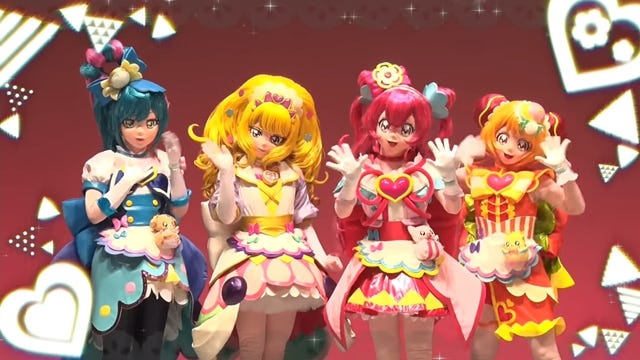
But much like these tokusatsu hero shows, PreCure often gets live action stage performances across Japan in places like theme parks. Actors will dress in full-body kigurumi costumes (kigurumi in this instance meaning a full costume including a stylized anime face mask to give the illusion that the anime character really exists on-stage, as opposed to the kigurumi that are basically cute onesie pajamas). They then perform as though playing out an episode of the TV show to an audience full of excited children.
And it’s not just children that love PreCure. I remember many years ago one of my earliest PreCure curiosity moments took place at All-Con in Dallas, Texas. For a couple of years, hosts Keisaku Kimura (currently a CG animator on Toei’s “Super Hero Time” shows) and Kazushi Hinoki (manga artist known for his art on Gun x Sword) would host 24-hour anime opening sing-alongs. These were truly wild and slightly unruly events, where participants were encouraged to drink and get loud with a literal 24-hour marathon of anisongs. At one point during one of these marathons in 2013, one of the blocks of songs was nothing but every single PreCure opening and ending theme up until that point in time. I’ll never forget Keisaku, dressed in a cosplay of Roy Mustang from Full Metal Alchemist, getting up from behind his table and joining Kazushi and some other Japanese men who’d come to this event to jump up in front of the projector and go full force both singing and dancing along with the PreCure girls, who at some point had started incorporating singing and dancing numbers into their ending themes. And these guys knew all of the lyrics and their entire dance routines. I had tried to walk past them at some point, and Keisaku had been flailing around to these PreCure songs so hard that he accidentally smacked me in the arm as I passed and ended up apologizing. Obviously, no harm, no foul, and I don’t hold it against him. That was one of the most wild things I’d ever seen.
For the record, Keisaku owns and operates this badass bar in Tokyo called Otaku Bar 44sonic. Having been a couple of times myself, it’s very small but is filled to the brim with anime and tokusatsu memorabilia, and Keisaku will make sure you have an awesome time singing karaoke to a bunch of anisongs. If you’re ever going to be in the area, I highly recommend it. It’s a super good time.
Anyway, I say all this to say that obviously I was not completely unfamiliar with PreCure as a franchise. It’s so immensely big and popular that it’s kinda hard to miss. And I’ve tried numerous times to start watching Futari wa Pretty Cure from the beginning. I recall Pretty Cure being one of Crunchyroll’s earliest licenses after coming off the heels of being one of the numerous streaming sites that hosted pirated fansubs. In fact, Pretty Cure may have been one of those pirated fansubs. And for the longest time, even up into recent years, those same fansub-quality videos were the only versions they had available, which I always thought was kinda weird for a streaming web site that had gone legit. And I don’t just mean the fact that the subtitles were hard encoded into the video, that they were using stylistic fonts and colors, and often relied on on-screen translators notes. Additionally, the video quality was incredibly poor and low resolution, and the audio quality left something to be desired. For being official, it genuinely was pretty difficult to watch.
That’s why it surprised me when I navigated through Crunchyroll’s library today, landed on Pretty Cure, and found that the video quality had been improved, and that the subtitles were now no longer using those hard-embedded and pretty fonts, instead using their more standardized and simplistic white font with a black outline that can be turned on or off. Although I did find that it still basically included at least one translator’s note, which would not have been my preference, but this is a significant improvement from the last time I’d tried to watch it. It certainly has upped my motivation to want to continue attempting to push through the series, when prior to this I’d never finished even this first season. I don’t know how long ago this update happened, but I’m glad it did.
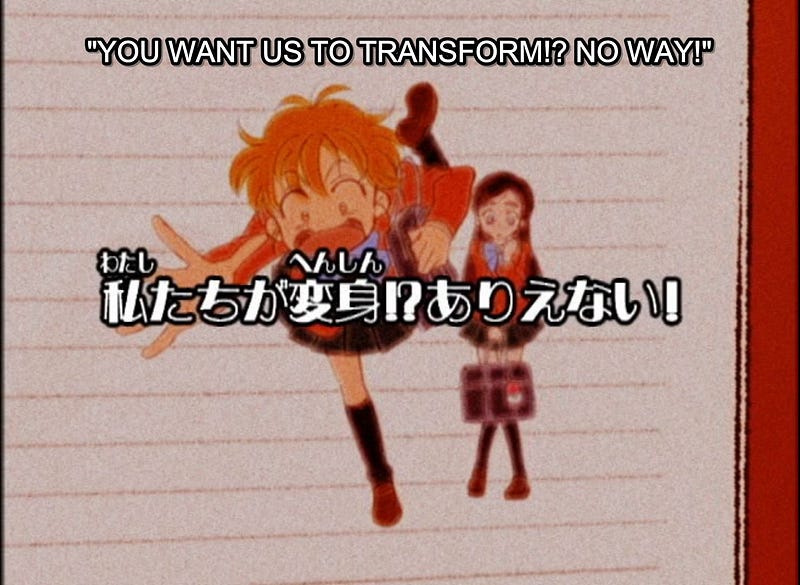
Episode one of Pretty Cure (originally aired February 1st, 2004) is relatively simplistic and formulaic as far as magical girl anime are concerned. It’s easy enough to see how the episode will play out if you’ve seen even one to two other magical girl shows. The girls meet some cute mascot creature, they get a magical transformation device, there’s a flashy transformation sequence, and they defeat a villain using magical powers they’ve never seen before. That having been said, there are some hallmarks about it that make it somewhat unique.
I enjoyed starting with the first of our two lead characters, Nagisa Misumi, in the middle of playing a game of lacrosse. That’s definitely an under-represented sport in the realm of anime. In fact, out of all the sports-themed anime out there, is there one based solely on lacrosse at all? (I just Googled it, and the answer is no, although there is apparently a lacrosse-themed manga called Baggataway. Could an anime adaptation ever come in the future?)
Meanwhile, we see our second hero Honoka Yukishiro doing some sciencey stuff in the school’s science lab, pouring some stuff into some other stuff and seeing what happens.
At first, the two girls really don’t know or have much of anything to do with one another. Though they quickly accidentally run into each other outside their shoe lockers as Nagisa and her friends are discussing the weird amount of shooting stars in the night sky lately. Honoka overhears the conversation and comments about how they’re actually rocks falling from space, and then walks away. Nagisa’s friends explain that they’d been in Honoka’s class last year and it turns out she’s actually really smart (if the science lab stuff and the talk about shooting stars didn’t make that obvious).
Ironically, as if written by fate (or just the writers of the show), Nagisa comes home after school, goes to her bedroom, and then sees a fairly impressive amount of shooting stars up in the early evening sky, and starts making wishes as if God’s giving them out on Oprah. Well, it turns out one of those shooting stars is actually headed right for her, and rockets through Nagisa’s open window and into her room. But it’s not just a normal space rock. It’s actually an alien in the shape of a mid-2000s-era flip phone with a cute squishy mascot character living inside it. The mascot introduces himself as Mepple (and uses “mepo” to end most his sentences). When Nagisa’s brother comes up to her room to check on her, Mepple hides himself inside his cell phone shell, successfully convincing the intruder that he is, in fact, just a broken plastic cell phone, and as the younger brother leaves, Mepple takes that opportunity to spit out a bunch of collectable cards. No explanation is given for the cards yet, so more on that later.
Anyway, when Mepple and Nagisa are alone again, Mepple is more comfortable spilling his guts to her, saying he needs her to help him by taking him to find someone by the name of Mipple. We don’t know who that is yet, but given we’ve seen some shots of Honoka also finding a space cell phone in a shed on her family’s property, we probably already have an idea of who Mipple is.
Nagisa is eventually convinced to carry Mepple around looking for Mipple, though she does so by carrying him in her lacrosse stick, maybe to avoid touching the weird alien that just rocketed into her bedroom. Much like birds always seem to know where magnetic north is, Mepple seems to be able to sense Mipple, and guides Nagisa to find her. The only problem is that he’s guiding her in a very literal straight line that doesn’t exactly take into consideration the societal infrastructure of Tokyo, Japan, leading Nagisa over walls, through neighbors’ backyards and into a restaurant kitchen to get to where they’re going.
While they’re on their trip across town, Mepple describes himself as the Chosen Guardian from the Field of Light, whatever that is. There’s not great elaboration for this just yet, so for now you kinda just have to take Mepple’s word for it.
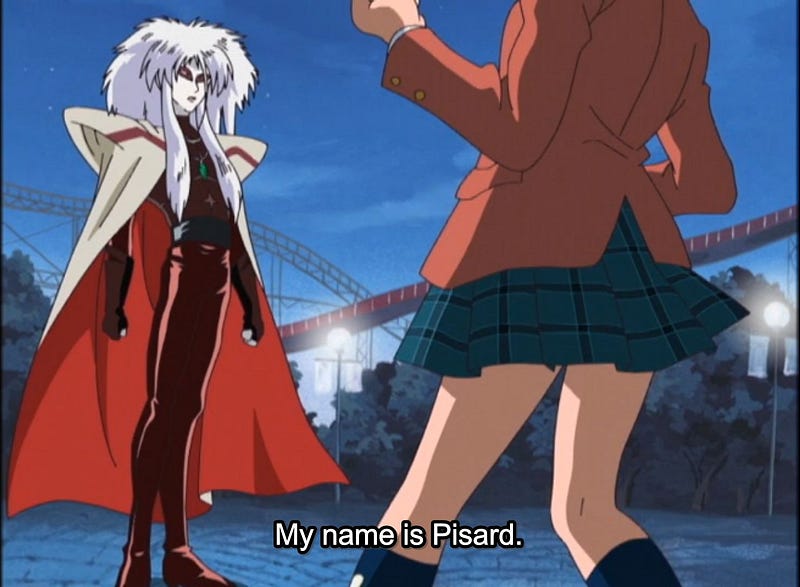
Eventually, Nagisa and Mepple make it to a theme park, which is conveniently in the middle of closing, so you know all the cool action will be happening with no potential victims remaining in the park. Unfortunately, Mepple is now realizing that the person he was sensing that he thought was Mipple is not in fact Mipple. Instead, they find themselves face-to-face with a guy looking like David Bowie in Jim Henson’s The Labyrinth if it was being performed by a kabuki troupe, who identifies himself a Pisard, saying he’s there to take Mepple. He fairly easily manages to snag Mepple from Nagisa’s possession, which thankfully is when Honoka shows up, carrying a very similar-looking cell phone with a poofy alien in it (yes, this is Mipple).
As Pisard is distracted by Honoka and Mipple, Nagisa manages to smack Mepple out of Pisard’s hand using her lacrosse stick and successfully takes him back. Of course, Pisard is mad about it and starts telepathically throwing objects around, like park benches and trash cans. And this is finally when the cool stuff you all came here to see happens.
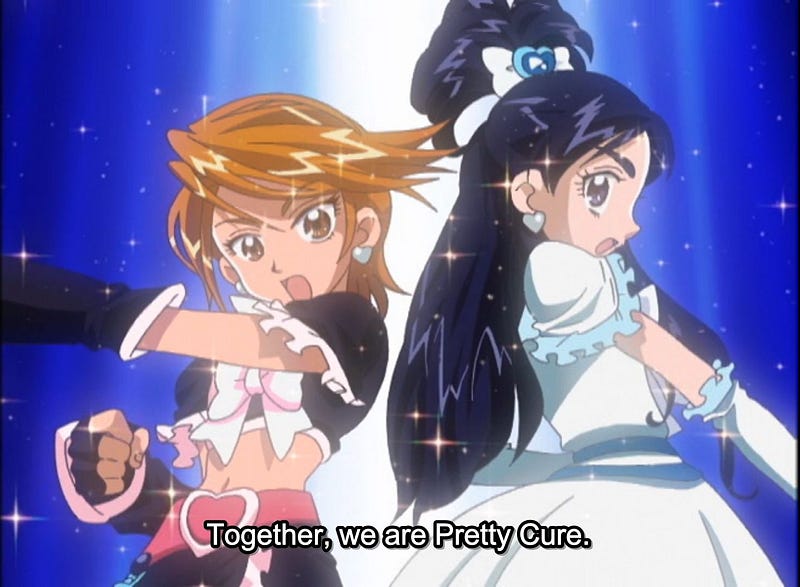
Mipple and Mepple command Honoka and Nagisa to find their own copies of a card they were given called the Queen card, and then to slide the barcode end of that card through the e-Reader-like slot at the bottom of their cell phones. This then triggers an extensive transformation sequence to turn both girls into the combined team known as Pretty Cure. Nagisa is known as Cure Black, and Honoka is known as Cure White. Just like many other magical girl shows, their transformation has instinctively taught both girls exactly what things to do and say, even if they had no previous reason to know how to say any of their cool catch phrases.
Unlike a lot of other magical girl shows, however, these girls are actually pretty decent physical fighters now. While shows like Sailor Moon would often spend a lot of time dodging attacks and then doing some kind of magic ability to save the day, Cure Black and Cure White are actually throwing a lot of cool punches and kicks and can do neat backflips. They actually come off feeling quite capable and competent.
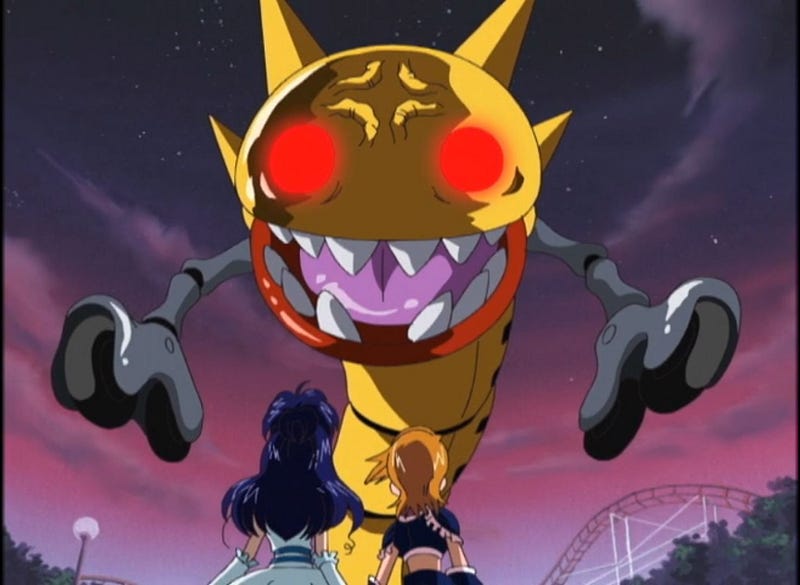
Unfortunately, Pisard is apparently able to make inanimate objects come to life and turn into monsters. A large, dark, spooky spirit of some kind with the name of Zakenna pops out, and then haunts an entire train of roller coaster cars, becoming a threatening roller coaster monster that for some reason can also shoot lasers out of his eyes.
Thankfully, there’s a solution to that. Cure Black and Cure White hold hands, summon lightning, and then perform the ability they call Pretty Cure Marble Screw, striking Zakenna and shattering him into a million tiny, screaming, scattering stars. That might be a difficult image to picture, but I promise it makes a little more sense when you watch it for yourself.
In the chaos of all of this, Pisard jumps unrealistically high into the sky and escapes the fight, left to wonder just who exactly these Pretty Cure girls really are and how it is they got to be so powerful. Though I feel like he should at least have partial understanding of how this happened, if he was chasing down Mepple in the first place. Did he not understand what Mepple was capable of doing? Oh, well, I guess that’s an answer for a later episode.
Nagisa and Honoka pull their new alien cell phones out of their new alien cell phone pouches that they now totally have after all this, and open them up to free Mepple and Mipple from their cellular prisons. In fact, they’ve completely popped out of their respective phones, now approximately the size of two large, fluffy cats, and are excitedly hugging each other now that they’ve been reunited. They also reiterate that the two girls are now known under the title of Pretty Cure and are the Protectors of Light. Again, whatever that means. Still doesn’t mean too much to us yet. I’m sure we’ll understand as the show goes on.
For now, though, that’s basically the end of the episode.
That originally was going to be where I was going to stop writing as well, but in preparing to write I learned something else that I’m sure people who are much more knowledged about PreCure than I am were already well aware of. Somehow, I’d long missed the fact that Canada’s Ocean Productions (famous for their dubs of other shows such as Mobile Suit Gundam and InuYasha) had also produced an English dub of Pretty Cure back in 2009, five years after its original release in Japan. Maybe I had missed it because it never aired in the United States, and therefore it had never quite crossed my radar. That briefly led to me searching for this dub (which had never seen a retail release after its broadcast).
Somehow, the dub actually wasn’t that difficult to find, if you know where to look. It’s a pretty fascinating localization, in fact. This opening sequence is a whole new mid-2000s butt rock song made just for this release, but aside from that as far as I could tell, the dub’s narrative was pretty faithful to its original Japanese story. That is, except for the fact that the characters names have unfortunately all been anglicized. Nagisa’s name is now Natalie, Honoka is now Hannah, and on it goes even with a bunch of background characters. Pisard gets off light with his name being pronounced somewhere closer to Pizz-ahrd. And yet for some reason it’s okay to leave Honoka’s pet dog’s name as Chutaro. I guess it’s fine when it’s not a human.
If I keep writing blogs about this show, I’m not too sure if I’ll keep watching the Japanese version back-to-back with the English version or not. There might be some interesting gems, but it could also get pretty time consuming pretty quickly. We’ll see as time goes on.
For now, I just think that the legacy of PreCure is very interesting, as well as the history of what has and has not been localized into English and distributed in the west, which is probably what has led me to want to dive into it a bit and write about it. I do admit, I usually fall off of personal blogging challenges like this after a while, so I hope I won’t disappoint any overly-enthusiastic PreCure fans too quickly. I’ll do my best to keep on top of this regularly for now.
Thanks for reading. Hope to be seeing you back here again on Medium soon, talking about more Futari wa Pretty Cure.
